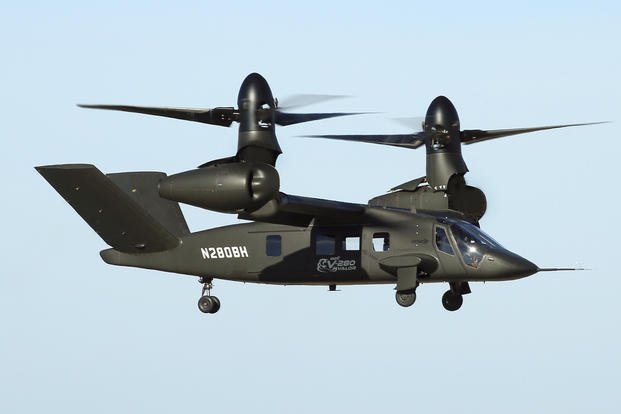On Monday evening, the Army announced Bell as the victor in the longstanding Future Long-Range Assault Aircraft (FLRAA) competition to replace the Army's aging fleet of Black Hawk helicopters, marking the branch's largest rotorcraft purchase in more than 30 years.
Following closely behind Friday's unveiling of its newest bomber, the Northrop Grumman B-21 Raider, the Army announced the contract award to Bell for its tilt-rotor V-280 Valor on Monday evening, continuing the world's glimpse into the future of American airpower.
"This is an exciting time for the US Army, Bell, and Team Valor as we modernize the Army's aviation capabilities for decades to come," Mitch Snyder, president and CEO of Bell, said in a statement published by Breaking Defense.
The FLRAA competition was supposed to conclude in June, but Army leaders announced that they needed more time to review the two competing bids; Bell's V-280 Valor and a joint Sikorsky-Boeing compound helicopter platform dubbed the SB-1 Defiant-X. In November, the Army said they'd released their decision by the end of the year, citing "quality control" and "due diligence" as the reason for the delay.
With up to $1.3 billion on the line under the current contract decision, however, it does seem likely that the Sikorsky-Boeing partnership will file a protest, potentially prolonging the timeframe between the contract decision and the program actually moving forward.
"We remain confident DEFIANT X is the transformational aircraft the US Army requires to accomplish its complex missions today and well into the future," read a Boeing-Sikorski statement released on Monday.
"We will evaluate our next steps after reviewing feedback from the Army."
The V-280 Valor Will Eventually Replace the Army's Massive Fleet of Black Hawks
The contract, which includes an initial award of $232 million over the next 19 months and as much as $1.3 billion in total is not to produce a fleet of operational rotorcraft, but rather to continue preliminary design work and eventually deliver "virtual prototypes of a potentially model-based system."
"There are zero aircraft being procured in the initial portion," Maj. Gen. Robert Barrie, the Army's Program Executive Officer for Aviation, explained.
It's nearly impossible to overstate the significance of this award. The U.S. Army alone currently operates a fleet of more than some 2,135 H-60-based helicopters (according to Lockheed Martin, which owns Sikorski), with at least 750 currently undergoing a series of avionics and system upgrades to bring them up to UH-60V standards.
However, the scope of this decision could grow even further, with at least 28 other nations currently operating Black Hawks or modified iterations that will likely follow the U.S. Army's lead. In fact, more than 4,000 H-60s of various sorts have been delivered to customers around the world to date.
What Do We Know About the V-280 Valor? It's FAST.
According to Bell, the V-280 Valor is an extremely capable tiltrotor aircraft that offers a combination of conventional helicopter and airplane capability sets. With a claimed top speed as high as 305 knots (originally 280, hence its name), or approximately 350 miles per hour, the Valor beats the Black Hawk's top speed by better than 100 miles per hour, alongside a high sling-load capability and the skill sets you'd expect of a tactical helicopter, like allowing troops carried onboard to fast-rope out of the aircraft while it hovers.
"Every time you hear the Chief or Maj. Gen. Rugen speak, it's about speed, range, and reach," said Frank Lazzara, director of Bell's Advanced Vertical Lift Systems, Sales and Strategy. Lazzara previously flew CV-22 Ospreys for Air Force's Special Operations Command.
"It's about the ability to mass combat force on an objective and close on the enemy as quickly as possible. All these things have been demonstrated by an operational tiltrotor without sacrificing performance at the X."
According to previous statements, the V-280 Valor can achieve these speeds while also carrying up to 25% more cargo or 23% more personnel -- all with a range of 800 nautical miles. For context, the Black Hawk offers an unrefueled range of just 362 miles.
The V-280's tilt-rotor design does create a wider footprint than the UH-60 Black Hawk, but Bell claims it makes up for that by being 20 percent shorter, allowing for a great deal of flexibility when landing. Tilt-rotor aircraft are, by Bell's own admission, more complex than conventional helicopters -- but with that complexity comes added capability, like sustained high speeds. And Bell points out that it has gained a great deal of experience making tilt-rotor platforms robust over 650,000 U.S. military flight hours accumulated operating the V-22 Osprey.
"What Bell did with the V-280 Valor was to evolve the tiltrotor configuration into a fighting machine designed specifically for the Army air assault and utility missions in contested environments and to be maintainable in the field," said Carl Coffman, vice president of Future Vertical Lift Strategy at Bell.
"We proved that this is not going to be a risky configuration for the Army to adopt because there is no component on the V-280 that you can't pull with organic ground-support equipment in an austere environment today."
The exact requirements the U.S. Army wants to see the V-280 Valor meet before it enters service remain classified.
Read the original article on Sandboxx.












